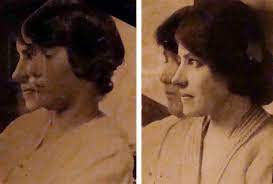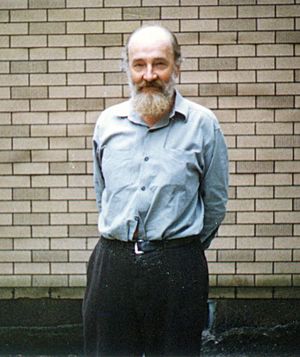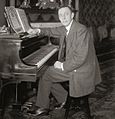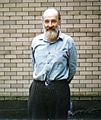Anna Anderson facts for kids
Quick facts for kids
Anna Anderson
|
|
|---|---|
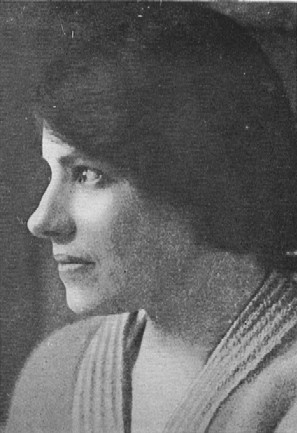 |
|
| Born |
Franziska Schanzkowska
16 December 1896 |
| Died | 12 February 1984 (aged 87) |
| Other names | Fräulein Unbekannt Anna Tschaikovsky Anastasia Tschaikovsky Anastasia Manahan |
| Known for | Impostor of Grand Duchess Anastasia Nikolaevna of Russia |
| Spouse(s) |
John Eacott "Jack" Manahan
(m. 1968) |
Anna Anderson (born Franziska Schanzkowska; 16 December 1896 – 12 February 1984) was a woman who claimed to be Grand Duchess Anastasia of Russia. Anastasia was the youngest daughter of the last Russian Tsar, Nicholas II, and his wife, Alexandra. The imperial family was killed by revolutionaries on 17 July 1918 in Yekaterinburg, Russia. For many years, the location of Anastasia's body was unknown.
In 1920, Anderson was found in Berlin and taken to a mental hospital. She refused to say who she was, so she was called Fräulein Unbekannt (Miss Unknown). Later, she used the names Tschaikovsky and then Anderson. In March 1922, people began to say that Anderson might be a Russian grand duchess. Most of Grand Duchess Anastasia's family and friends believed Anderson was not Anastasia. However, some people were convinced she was. In 1927, an investigation identified Anderson as Franziska Schanzkowska, a Polish factory worker with a history of mental health issues. After a long legal battle, German courts ruled that Anderson could not prove she was Anastasia. Despite this, her claim became very famous through media stories.
Between 1922 and 1968, Anderson lived in Germany and the United States. She stayed with various supporters and in care homes. In 1968, she moved to the United States. She married history professor Jack Manahan shortly before her visa expired. He was known as an "eccentric" person. When she died in 1984, Anderson's body was cremated. Her ashes were buried in Germany at Castle Seeon. After the fall of communism in the Soviet Union, the bodies of the Tsar, Tsarina, and all five of their children were found. DNA testing later confirmed their identities. DNA tests on Anderson's hair and tissue showed she was not related to the Romanovs. Instead, her DNA matched that of a relative of Franziska Schanzkowska. Most scientists and historians now agree that Anna Anderson was Franziska Schanzkowska.
Contents
- The Mystery Begins: Dalldorf Asylum (1920–1922)
- Life in Germany and Switzerland (1922–1927)
- The Investigation at Castle Seeon (1927)
- Journey to the United States (1928–1931)
- Life in Germany (1931–1968)
- Final Years in the United States (1968–1984)
- DNA Evidence: Solving the Mystery
- Understanding Anna Anderson's Claim
- Anna Anderson in Fiction
- Images for kids
- See also
The Mystery Begins: Dalldorf Asylum (1920–1922)
On 27 February 1920, a young woman tried to jump from a bridge in Berlin. A police officer saved her. She was then taken to a hospital. Because she had no papers and would not say who she was, she was sent to a mental hospital in Dalldorf. She stayed there for two years. The unknown patient had scars on her head and body. She spoke German with an accent that staff described as "Russian."
In early 1922, another patient, Clara Peuthert, said the unknown woman was Grand Duchess Tatiana of Russia. Tatiana was one of Tsar Nicholas II's daughters. After leaving the hospital, Peuthert told a Russian émigré (someone who left their home country) named Captain Nicholas von Schwabe about her. Schwabe visited the hospital and believed the woman was Tatiana. He convinced other émigrés to visit her. These included Zinaida Tolstoy, a friend of Tsarina Alexandra.
Eventually, Baroness Sophie Buxhoeveden, who had been a lady-in-waiting to the Tsarina, visited. When she saw the woman, Buxhoeveden said, "She's too short for Tatiana." She left convinced the woman was not a Russian grand duchess. A few days later, the unknown woman said, "I did not say I was Tatiana." A nurse later claimed the woman had told her in 1921 that she was another daughter of the Tsar, Anastasia. However, the patient herself could not remember saying this.
Life in Germany and Switzerland (1922–1927)
By May 1922, some people, like Peuthert and Schwabe, believed the woman was Anastasia. She was moved from the hospital to the home of Baron Arthur von Kleist in Berlin. Kleist was a Russian émigré. The Berlin policeman on the case, Detective Inspector Franz Grünberg, thought Kleist might have had other reasons for helping her. He hoped for a good position if the old Russian government ever returned.
The woman began to call herself Anna Tschaikovsky. She chose "Anna" as a shorter version of "Anastasia." Tschaikovsky stayed in the homes of different people who supported her. Inspector Grünberg arranged for the Tsarina's sister, Princess Irene of Hesse and by Rhine, to meet Tschaikovsky. But Irene did not recognize her. Grünberg also arranged a visit from Crown Princess Cecilie of Prussia. Tschaikovsky refused to speak to her, leaving Cecilie confused. Years later, Cecilie signed a paper saying Tschaikovsky was Anastasia, but her family said she might have had memory problems.
By 1925, Tschaikovsky had a serious infection in her arm. She was treated in several hospitals. She lost a lot of weight and was very ill. Many people who knew Anastasia visited her. These included Anastasia's tutor, Pierre Gilliard, and his wife, Alexandra Tegleva, who had been Anastasia's nursemaid. The Tsar's sister, Grand Duchess Olga, also visited. They felt sorry for her because she was sick. But in the end, they all said she was not Anastasia.
In March 1926, she went to recover in Lugano, Switzerland. This was paid for by Grand Duchess Anastasia's great-uncle, Prince Valdemar of Denmark. Valdemar wanted to help Tschaikovsky while her identity was being checked. To help her travel, she was given a temporary ID as "Anastasia Tschaikovsky." After an argument, Tschaikovsky moved to a sanatorium in Oberstdorf, Germany, in June 1926.
At Oberstdorf, Tatiana Melnik visited Tschaikovsky. Melnik was the niece of the head of the Russian refugee office in Berlin. Her father, Dr. Eugene Botkin, was the imperial family's doctor and was killed with them. Tatiana Melnik had met Grand Duchess Anastasia as a child. She thought Tschaikovsky looked like Anastasia, though her mouth had changed. Melnik wrote that Tschaikovsky acted like a child and had trouble remembering things. She also spoke German poorly. Melnik believed Tschaikovsky was Anastasia. She thought her memory problems and refusal to speak Russian were due to her illness. Melnik tried to help Tschaikovsky remember details about the imperial family.
The Investigation at Castle Seeon (1927)
In 1927, Prince Valdemar stopped financially supporting Tschaikovsky. Duke George of Leuchtenberg, a distant relative of the Tsar, gave her a home at Castle Seeon. The Tsarina's brother, Ernest Louis, Grand Duke of Hesse, hired a private detective named Martin Knopf. Knopf was to investigate Tschaikovsky's claim.
During her stay at Castle Seeon, Knopf reported that Tschaikovsky was actually a Polish factory worker. Her name was Franziska Schanzkowska. Schanzkowska had worked in a factory during World War I. She was injured in the head when a grenade exploded. She became very sad and was declared to have mental health issues in 1916. She spent time in two care facilities. In early 1920, she disappeared from her home in Berlin. Her family had not seen or heard from her since.
In May 1927, Franziska's brother, Felix Schanzkowski, met Tschaikovsky. Leuchtenberg's son, Dmitri, was sure Tschaikovsky was an impostor and that Felix recognized her. But Leuchtenberg's daughter, Natalie, still believed Tschaikovsky was Anastasia. Felix first said Tschaikovsky was his sister. However, the official statement he signed only mentioned a "strong resemblance." It also pointed out physical differences and said she did not recognize him. Years later, Felix's family said he knew Tschaikovsky was his sister. But he chose to let her live her new, more comfortable life.
Other visitors to Seeon included Prince Felix Yusupov, who was married to Anastasia's cousin. He wrote that she was "just an adventuress, a sick hysteric and a frightful playactress." He could not understand how anyone could doubt this. However, others, like Felix Dassel, an officer Anastasia had visited in the hospital, and Gleb Botkin, who knew Anastasia as a child, were convinced she was real.
Journey to the United States (1928–1931)
By 1928, Tschaikovsky's story had gained interest in the United States. Gleb Botkin, Tatiana Melnik's brother, wrote articles supporting her. His efforts caught the attention of Xenia Leeds, a distant cousin of Anastasia. Leeds was a former Russian princess who had married a rich American businessman. Botkin and Leeds arranged for Tschaikovsky to travel to the United States. She sailed on the ship Berengaria at Leeds's expense.
On her way to the U.S., Tschaikovsky stopped in Paris. There, she met Grand Duke Andrei Vladimirovich of Russia, the Tsar's cousin, who believed she was Anastasia. For six months, Tschaikovsky lived at the Leeds family estate in New York.

As the tenth anniversary of the Tsar's execution neared in July 1928, Botkin hired a lawyer, Edward Fallows. Fallows wanted to claim any of the Tsar's money outside of the Soviet Union. Tschaikovsky claimed the Tsar had money in other countries. This led to rumors of a large Romanov fortune in England. The Tsar's remaining relatives accused Botkin and Fallows of trying to get rich. Botkin accused them of trying to cheat "Anastasia" out of her inheritance. No large fortune was ever found, except for a small amount in Germany.
After an argument, Tschaikovsky moved out of the Leeds' mansion. The famous pianist Sergei Rachmaninoff helped her find a place to live. She stayed at the Garden City Hotel and later in a small cottage. To avoid the press, she was called Mrs. Anderson. This is the name she was known by afterward. In October 1928, after the death of the Tsar's mother, the Dowager Empress Marie, 12 of the Tsar's closest relatives met. They signed a statement saying Anderson was an impostor. They called her story "only a fairy tale." Gleb Botkin responded with a public letter, calling the family "greedy."
From early 1929, Anderson lived with Annie Burr Jennings, a wealthy woman in New York City. Jennings was happy to host someone she thought was the Tsar's daughter. For 18 months, Anderson was popular in New York society. Then, she began to act in ways that caused problems for herself. On 24 July 1930, a judge ordered her to a mental hospital. She locked herself in her room, and the door had to be broken down. She was taken to a care facility in New York. She stayed there for a little over a year. In August 1931, Anderson returned to Germany. Jennings paid for her trip and her stay in a care facility in Germany. When she arrived, Anderson was judged to be mentally sound. But since her room was paid for, she stayed there.
Life in Germany (1931–1968)
Anderson's return to Germany created more press interest. More German noble families began to support her. She continued to live as a guest of her supporters. In 1932, a British newspaper accused her of being a Romanian actress who was tricking people. Her lawyer, Fallows, sued for libel (a false written statement that harms someone's reputation). But the case lasted until World War II began. It was then dismissed because Anderson was living in Germany, an enemy country.
From 1938, lawyers for Anderson in Germany challenged how the Tsar's estate was being given to his recognized relatives. They, in turn, questioned her identity. The legal case went on for decades without being solved. Lord Mountbatten, a cousin of the Romanov children, helped pay some of his German relatives' legal bills against Anderson. This long legal process became the longest lawsuit in German history.
Anderson had a final meeting with the Schanzkowski family in 1938. Gertrude Schanzkowska insisted that Anderson was her sister, Franziska. The Nazi government had arranged the meeting to find out Anderson's identity. If she was accepted as Schanzkowska, she would be imprisoned. The Schanzkowski family refused to sign statements against her. No further action was taken. In 1940, Edward Fallows died with almost no money. He had spent all his own money trying to get the Tsar's non-existent fortune.
Towards the end of World War II, Anderson lived with Louise of Saxe-Meiningen. In 1946, Prince Frederick of Saxe-Altenburg helped her cross the border to a safer area. Prince Frederick settled Anderson in a former army building in a small village. She became a kind of tourist attraction there. Lili Dehn, a friend of Tsarina Alexandra, visited her and said she was Anastasia. But when Charles Sydney Gibbes, the English tutor to the imperial children, met Anderson, he said she was a fraud. He swore in a statement, "She in no way resembles the true Grand Duchess Anastasia that I had known."
Anderson became a recluse, living alone with many cats. Her house began to fall apart. In May 1968, Anderson was found unconscious in her cottage and taken to a hospital. While she was gone, Prince Frederick cleaned up her property and removed all her pets. Anderson then accepted her long-time supporter Gleb Botkin's offer to move back to the United States.
Final Years in the United States (1968–1984)
Gleb Botkin lived in Charlottesville, Virginia. A friend of his, history professor John Eacott "Jack" Manahan, paid for Anderson's trip to the United States. She entered the country on a six-month visitor's visa. Just before it expired, Anderson married Manahan on 23 December 1968. He was 20 years younger than her. Botkin was the best man. Jack Manahan enjoyed this marriage of convenience. He called himself "Grand Duke-in-Waiting." The couple lived in separate bedrooms in Charlottesville. They also owned a farm. Botkin died in December 1969. In February 1970, the lawsuits about Anderson's identity finally ended. Neither side could prove her identity.
Manahan and Anderson, now legally named Anastasia Manahan, became known in Charlottesville as unusual people. Even though Jack Manahan was wealthy, they lived in a messy house with many dogs and cats. On 20 August 1979, Anderson was taken to the hospital with an intestinal problem. In November 1983, with both of them in poor health, Anderson was placed in a care facility. A lawyer was appointed as her guardian. A few days later, Manahan "kidnapped" Anderson from the hospital. They drove around Virginia for three days. After a police search across 13 states, they were found. Anderson was returned to a care facility. In January, she was thought to have had a stroke. On 12 February 1984, she died from pneumonia. She was cremated the same day. Her ashes were buried in Germany at Castle Seeon on 18 June 1984. Manahan died on 22 March 1990.
DNA Evidence: Solving the Mystery
In 1991, the bodies of Tsar Nicholas II, Tsarina Alexandra, and three of their daughters were dug up from a mass grave in Russia. The bodies of Tsarevich Alexei and the remaining daughter were found in 2007. Many independent DNA tests confirmed that these were the seven members of the Romanov family. The tests proved that none of the Tsar's four daughters survived the shooting of the Romanov family.
A sample of Anderson's tissue had been saved at a hospital in Charlottesville, Virginia. Anderson's mitochondrial DNA was taken from this sample. It was then compared with the DNA of the Romanovs and their relatives. The test confirmed that Anderson was not related to the Romanovs. However, the sample matched DNA from Karl Maucher. Maucher was a great-nephew of Franziska Schanzkowska's sister. This showed that Karl Maucher and Anna Anderson were related through their mothers. It proved that Anderson was Franziska Schanzkowska. Five years later, Dr. Terry Melton, a DNA expert, said that the DNA link between Anderson and the Schanzkowski family was "still unique." This meant there was even more certainty that Anderson was indeed Franziska Schanzkowska.
Also, several strands of Anderson's hair were found inside an envelope in a book that belonged to her husband, Jack Manahan. Mitochondrial DNA from the hair was also tested. It matched Anderson's hospital sample and the DNA of Schanzkowska's relative, Karl Maucher. But it did not match the Romanov remains or their living relatives.
Understanding Anna Anderson's Claim
Even though the entire imperial Romanov family was killed in July 1918, rumors spread that some members had survived. This was partly due to false information from the communist government. These rumors allowed people to make false claims that they were a surviving Romanov.
Most of these impostors were quickly dismissed. However, Anna Anderson's claim lasted for a long time. Books and articles were written both supporting and denying her claims. People used conflicting stories and physical evidence, like facial comparisons, to argue their points. Without clear proof, whether Anderson was Anastasia became a matter of personal belief for many. As Anderson herself once said, "You either believe it or you don't believe it. It doesn't matter. In no anyway whatsoever." The German courts could not decide her claim. After 40 years, they ruled that her claim was "neither established nor refuted."
Experts have different ideas about Anna Anderson. Some think she was a deliberate trickster. Others believe she was confused or had adopted a new identity because of trauma. Some think her supporters used her for their own purposes. Pierre Gilliard, Anastasia's tutor, called Anderson "a cunning psychopath." The idea that Anderson was a member of the imperial family first came from another patient in the hospital, not from Anderson herself. Writer Michael Thornton thought, "Somewhere along the way she lost and rejected Schanzkowska. She lost that person totally and accepted completely she was this new person." Lord Mountbatten, a cousin of the Romanov children, believed her supporters were "simply get rich on the royalties of further books, magazine articles, plays etc." Prince Michael Romanov, a grandson of Grand Duchess Xenia Alexandrovna of Russia, said the Romanov family always knew Anderson was a fraud. He felt that she and the "three-ringed circus" around her insulted the memory of the Imperial Family.
Anna Anderson in Fiction
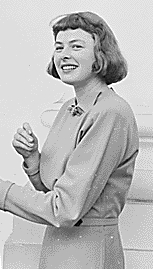
Since the 1920s, many fictional stories have been inspired by Anna Anderson's claim. In 1928, the silent film Clothes Make the Woman was loosely based on her story. In 1953, a play called Anastasia was written. It was so popular that in 1956, it was made into a film, also called Anastasia, starring Ingrid Bergman. The film is about a group of con artists who try to make money by pretending Grand Duchess Anastasia is still alive. They train a woman named "Anna" to act like Anastasia. The film leaves the audience to decide if Anna is truly Anastasia. Another film, Is Anna Anderson Anastasia?, starring Lilli Palmer, was released at the same time.
Playwright Royce Ryton wrote I Am Who I Am about Anna Anderson in 1978. Like earlier plays, it showed Anderson as a good person who was hurt by others' greed and fears. It did not try to decide her real identity.
Sir Kenneth MacMillan's ballet Anastasia, first performed in 1967, was inspired by Anderson's story. It is a dramatic fantasy about Anna Anderson, who believes she is Anastasia. She experiences parts of Anastasia's past in her memory or imagination. The ballet is like a "free-wheeling nightmare."
In 1986, a two-part TV mini-series called Anastasia: The Mystery of Anna was released. It starred Amy Irving, who won an award nomination for her role. The show keeps the audience guessing whether she truly believes her own story or if she is a clever trickster.
The main character, "Anastasia" or "Anya," in the 1997 animated fantasy film Anastasia is shown as the real Grand Duchess Anastasia. This film was made after DNA tests proved Anna Anderson was not Anastasia. However, the film was based on the 1956 movie and other stories. The directors decided the real history was too dark for a children's film. While generally liked, some of Anastasia's relatives felt the film was not respectful. But most Romanovs have come to accept the repeated use of Anastasia's romantic story.
Images for kids
-
Pianist and composer Sergei Rachmaninoff paid for Anna to stay at the Garden City Hotel on Long Island, where she first used the name Anderson.
-
Actress Ingrid Bergman won an Academy Award for her starring role as "Anna/Anastasia" in the 1956 film Anastasia. Though inspired by Anderson's claim, the film is largely fictional.
See also
 In Spanish: Anna Anderson para niños
In Spanish: Anna Anderson para niños


